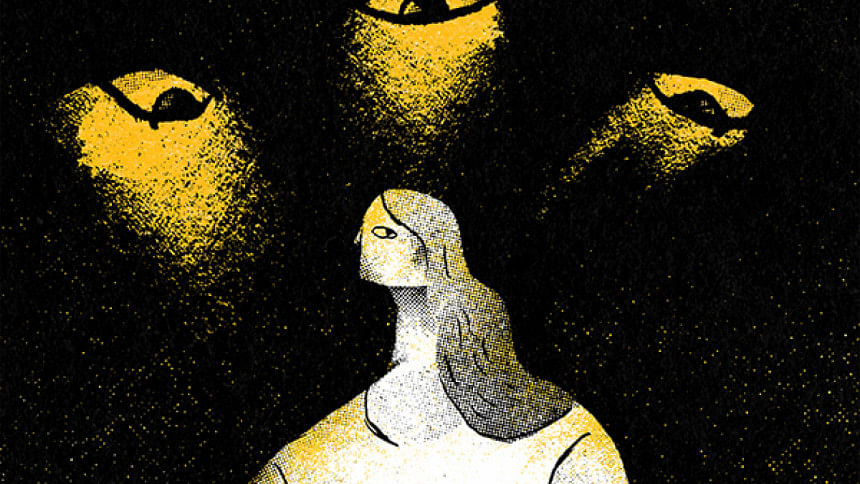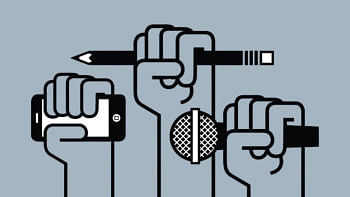Whither law enforcers?

Once again, a headline in The Daily Star grated: "Fifth-grader 'raped' by headmaster." Another headline literally stung: "RMG worker gang-raped in moving bus." Violence against women continues inexorably and with inexplicable regularity, reflecting the unconscionable disregard and disrespect that is held today for the helpless victims. Where does such abjectness come from? Is there something in the male ethos, some sense of entitlement? Is it patriarchal values? One wonders how long this will continue, especially when there are appropriate agencies of the government empowered and entrusted to bring an end to such vile acts.
A recent report points out that rape conviction rates are as low as 2 percent of all cases filed. The message sexual predators get is that they need not fear any consequences. There is also no known study in the country estimating the percentage of the total rape violations that is filed as cases. The reasons why cases are not filed or why conviction rate is so low include: outside court settlements; victims have to prove rape allegations, which is often quite difficult; victims undergo a humiliating process during investigation, medical tests and trial; victim's lack of awareness about immediate steps after rape; and police ignorance and negligence of duties.
It is important to examine the role of the appropriate authorities in the matter of curbing violence against women. For some reason they have simply failed to instil fear and respect for the law. In a study conducted by BRAC University on sexual harassment of women in public transportation, there were many complaints from female commuters regarding the role of law enforcement personnel. According to them, law enforcers show a serious lack of concern on complaints about harassment. A working woman grieved, "To whom should I go… the police? I looked for help after being harassed and they ended up laughing and said that I should not make a big deal out of this silly little thing." She further added, "It's not good for a woman to go to a male police officer for such issues… they simply cannot comprehend our pain [and loss of dignity]. We need female police officers everywhere to help us."
A larger group of women, sexually harassed in public transportation, were asked whether they had reported their experience to the authorities. The majority of respondents (46 percent) felt no need to do so, suggesting that they had probably become inured to the situation that "men will be men" and that they will not get any justice.
Many working women have taken to using public transportation for their daily commute in quest of a better livelihood. As they step out of the safety of their homes, what awaits them is unabashed nastiness, incomprehensible ugliness, and plain violence. In the crowded spaces of public transportation, "things happen"—but the women have nowhere to turn. The consequence is quite disconcerting: among many women, there appears to be a growing acceptance that "such things" will happen. Some may justify that a nudge or a push may be unavoidable in close quarters.
Unfortunately, matters often get worse: from groping and staring lewdly to far worse. What recourse do the women have in such circumstances? The study found that a large proportion of them (80 percent) remain silent or simply walk away. As for reporting to the authorities, 18 percent feared further harassment, 6 percent feared for their dignity, 3.36 percent felt it was no use complaining, and another 3.36 percent indicated that they did not need any more trouble.
Respondents were also asked if they felt the law-enforcers were women-friendly. A great number of them (72 percent) "strongly disagreed." Only about 7 percent felt the authorities were friendly, while 11 percent remained neutral. What the women seem to be saying is that law enforcers "must" do their job better and be much more proactive in protecting them. A seeming lack of trust in their demeanour is unmistakable.
It is indeed important to investigate further why law-enforcers are disinclined to protect women in public spaces and what needs to be done to change their perceptions, attitudes and behaviours to enable women to function with dignity and respect in the public sphere. It is also important to investigate whether there is a class of perpetrators the law enforcers are simply unwilling to confront.
The "brand-image" of law enforcement authorities is certainly not a healthy one and requires sustained pressure and imagination to turn around. Serious public discourse must be initiated on the measures needed to address the scourge of violence against women and the role of the authorities to bring change.
The role of the media can be vital in this matter, especially in "following up" on every reported case of violence to its ultimate conclusion. The public must know what consequences were faced by the perpetrators of violence: very often this matter is ignored, leaving the public wondering.
Training and capacity building is a third line of engagement: a special force may be developed for immersion into the system to deter the vile acts—under cover, if need be. The need for more and better quality public transportation has been underscored in numerous studies. Why that has not happened remains an enigma.
Deep-rooted cultural (patriarchal) values must also begin to be addressed from an early age. This means that schooling should play a larger change-agent role, early on, to shape appropriate behaviours of boys and girls as they transition to becoming men and women.
Finally, it is important to conduct more public opinion surveys on the state of violence against women where women are allowed to speak up. Such surveys can set benchmarks against which the state of law enforcement is continuously held up to public scrutiny. The high command within the law enforcement system must be held accountable in the main. When the opinion polls reflect positive results, the higher-ups must be publicly recognised and commended. When the polls go the other way, measures for incompetence must be visibly implemented. Women have endured, and continue to endure, a high level of violence. This ought to be unacceptable to any society. It is time for change—visible and palpable change.
Syed Saad Andaleeb is Vice Chancellor of BRAC University, Distinguished Professor Emeritus, Pennsylvania State University, and principal investigator of the study on women in public transportation, supported by the BRAC Road Safety Program and aided by the BRAC Gender Justice and Diversity Program.





Comments